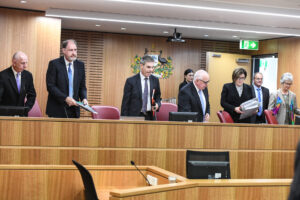Budget 2019-20: Ooops, They Did It Again!
You would think that after 5 consecutive years of wage forecasts that wildly overestimated actual experience, the government might have learned from its past errors – and published a wage forecast more in line with reality. But not this government. They are still trying to convince Australian workers, who haven’t seen real average wages rise in over 5 years, that better times are just around the corner. And rosy wage forecasts are helpful in justifying their equally optimistic revenue forecasts: since if Australians are earning more money, they will be paying more taxes!
So the 2019-20 Commonwealth budget, tabled Tuesday evening by Treasurer Josh Frydenberg, featured another valiant prediction that fast wage growth is indeed still “just around the corner.” Despite a slowdown in wage growth in the last months of 2018, this budget simply replicates last year’s wage forecast – but delayed by one more year. Crucially, there is no discussion justifying why Australian workers might have confidence in this year’s forecast, when the last five so widely missed the mark (and always in the same direction).
Our analysis of the 2019-20 Commonwealth budget focuses on the wages crisis facing Australian workers, and challenges the claim that cutting personal tax cuts can somehow compensate workers for the fact that their wages are not growing.
Annual wage increases generate compounding benefits for workers and their families: since each year’s raise is applied against a larger and larger base. That cannot happen with tax cuts: to the contrary, their incremental effect can only shrink over time (as tax rates get lower and lower). Moreover, tax cuts always come with a significant cost: the loss of foregone public services, income supports and infrastructure that is the inevitable consequence of government’s shrinking revenue base.
The tax cuts in this budget increase disposable incomes for workers by less than 1% (and by zero for the lowest-wage workers). In contrast, just one year of a normal wage increases delivers several times more benefits. And annual increases over three years (the term of the next government) delivers benefits dozens of times larger.
Please read and share our full analysis of the 2019-20 budget below, which explains in detail how tax cuts cannot compensate for stagnant wages. You are also invited to view and share this short video summarising the argument (prepared with the help of our colleagues at the Australia Institute).
Related documents
You might also like
Commonwealth Budget 2025-2026: Our analysis
The Centre for Future Work’s research team has analysed the Commonwealth Government’s budget, focusing on key areas for workers, working lives, and labour markets. As expected with a Federal election looming, the budget is not a horror one of austerity. However, the 2025-2026 budget is characterised by the absence of any significant initiatives. There is
The continuing irrelevance of minimum wages to future inflation
Minimum and award wages should grow by 5 to 9 per cent this year
Want to lift workers’ productivity? Let’s start with their bosses
Business representatives sit down today with government and others to talk about productivity. Who, according to those business representatives, will need to change the way they do things?

